|
 Clavaria amoena Clavaria amoena
SynonymsClavulinopsis amoena
Clavulinopsis aurantia
BiostatusPresent in region - Indigenous. Non endemic
Images (click to enlarge)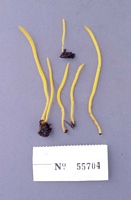
Caption: Microfiche 1-4. Clavaria amoena. TENN no. 43573. | 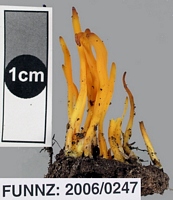
Caption: FUNNZ: 2006/0247, See public note for more information
Owner: FUNNZ | 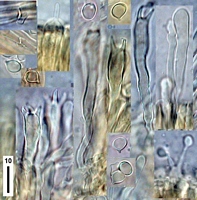
Caption: FUNNZ: 2006/0247, See public note for more information
Owner: FUNNZ | 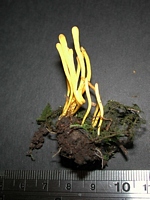
Owner: J.A. Cooper | 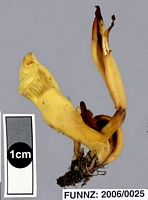
Caption: FUNNZ: 2006/0025, See public note for more information
Owner: FUNNZ |
Article: Petersen, R.H. (1988). The clavarioid fungi of New Zealand. New Zealand Department of Scientific and Industrial Research, Bulletin 236: 170 pp. Wellington:.
Description: Fruit bodies up to 50 x 2 mm, simple clubs, cylindrical, equal, uninflated, gregarious, bright
yellow ("apricot yellow", "cadmium yellow") all over except stipe base. Stipe up to 17 x 1.5
mm, terete, equal, arising from a small whitish mycelial patch, pale below ("light
cadmium"), concolorous to club above. Club opaque; apex rounded. Odour negligible; taste
negligible.
Macro chemical reaction: FCL = negative to obscurely weakly grey-green.
Tramal hyphae of club 3-7 µm diam., hyaline to pale yellow, clamped, occasionally
secondarily septate, parallel, free. Subhymenium extensive. Hymenium thickening,
congested, of two elements: (a) >basidia 40-50 x 6-8 µm, clavate, refringent, multiguttulate
when mature, (2)-4-sterigmate; and (b) less inflated to uninflated leptocystidial to basidiolar
processes, sinuous to lobed when uninflated, more refringent with inflation.
Spores 5.9-7.0 x 4-4.5 µm (Lm = 6.45 µm), ellipsoid to ovate, smooth, thin-walled, refringent
to greenish yellow under phase contrast; contents uniguttulate when mature; hilar appendix small, inconspicuous.
Notes: I have laboured over this name for years, finally pinning it to the above concept (Petersen
1979). The taxon seems to be distributed over the Southern Hemisphere, at least in temperate
areas. For a more complete description see Petersen (1979) under Clavaria aurantia, a
synonym used before I examined the type specimen of C. amoena.
|